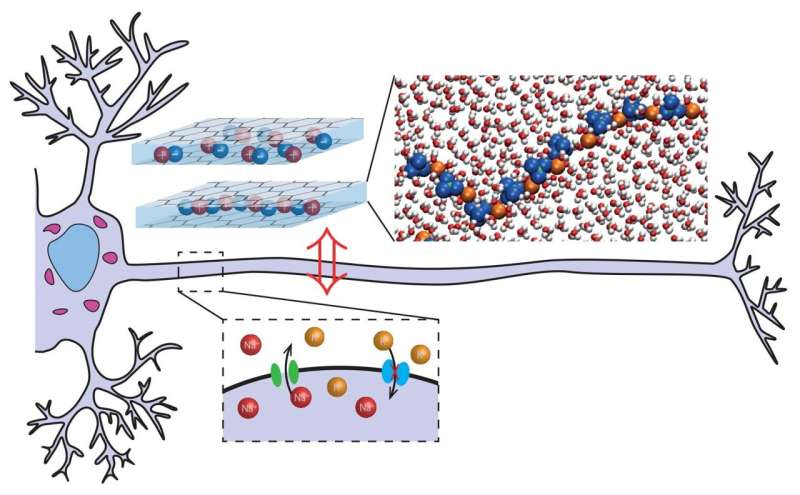August 6, 2021 report
Theories predict 2D nanofluidic channels showing nonlinear conduction function as memory-effect transistors

A team of researchers at Sorbonne Université has developed a way to show 2D nanofluidic channels carrying out nonlinear conduction functions as memory-effect transistors, using theory and simulations. In their paper published in the journal Science, the group describes their work with aqueous electrolytes confined in a two-dimensional gap between graphite layers and what they learned from it. Yaqi Hou and Xu Hou with Xiamen University have published a Perspective piece in the same journal issue outlining work involved in replicating the ways that neurons communicate using ionic and neurotransmitter conduction, and the work done by the team in France.
As Hou and Hou note, computer components communicate with one another using electrical conduction, which is a system that leads to intensive energy consumption in large systems. They note also that in looking for a more efficient approach, computer scientists have been studying the ways that biological systems communicate—most notably, neurons in the human brain. In so doing, they have noted that these communications are based on ions and chemicals moving through aqueous solutions. To that end, some work has been done by various groups to find out if computers could use similar channeling systems. In this new effort, the researchers developed theories regarding how such channels might work in a 2D system confined between two planes—in their case, layers of graphite—and then ran simulations to show that their approach might work in a real computer system.

The researchers note that advances in nanofluids have allowed for the creation of aqueous solutions made of single layers of molecules. Such electrolytes, they note, have hinted at the possibility of their use as means of ion transport, similar to that seen in human neurological networks. To create such a system, the researchers developed several theories to predict the behavior and effects of such a scenario in a well-defined system; aqueous electrolytes transporting information across tiny, 2D slits in graphite layers when they are exposed to an electric field. In so doing, they found that if done in a certain way, the ions would form into clusters that exhibit hysteretic conduction, an indication that the system could be used to create an artificial neuron. The researchers then created a simulation of their ideas to demonstrate their feasibility.
More information: Paul Robin et al, Modeling of emergent memory and voltage spiking in ionic transport through angstrom-scale slits, Science (2021). DOI: 10.1126/science.abf7923
Journal information: Science
© 2021 Science X Network





















